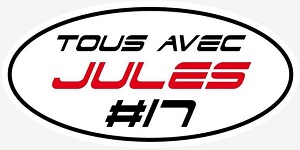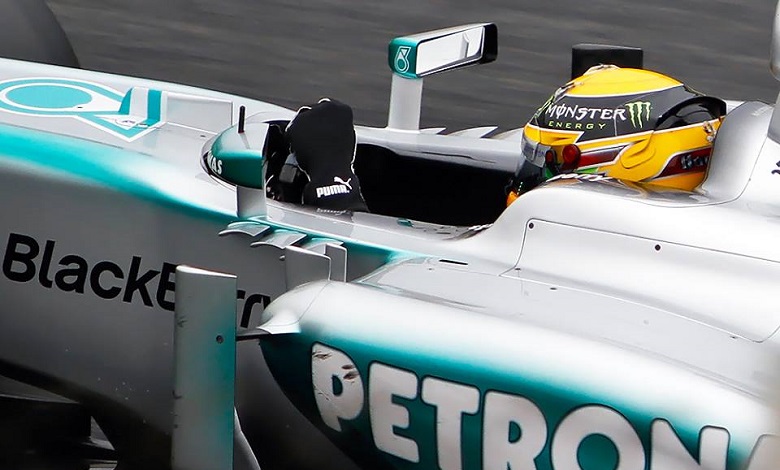La FIA si auto-assolve per l’incidente di Bianchi in Giappone: la colpa è sua! Arrivederci e grazie…
Ieri è stato divulgato il risultato dell’analisi dell’Accident Panel incaricato di esaminare le circostanze dell’incidente occorso a Jules Bianchi durante il Gran Premio del Giappone, lo scorso 5 Ottobre, sul circuito di Suzuka. Un esito atteso, dal contenuto in parte condivisibile, ma nel complesso vomitevole

Parigi – La colpa non è del maggiordomo, ma solo perché il maggiordomo non c’era.
Tuttavia, con l’approssimarsi del Natale, la FIA – Federazione Internazionale dell’Automobile – ha fatto alla famiglia di Jules Bianchi e agli appassionati che mantengono una certa lucidità mentale (e anche qualche appiglio etico) un regalo anticipato, divulgando i risultati dell’Accident Panel incaricato di indagare sull’incidente incorso al pilota francese di origini italiane al 43° giro del Gran Premio del Giappone, lo scorso 5 ottobre. Suzuka, da luogo del disonore (della FIA, della FOM e del modo di organizzare e gestire un evento iridato: non dei giapponesi. È importante precisarlo) a luogo del caso.
Infatti, la decisione degli investigatori-su-se-stessi non è una decisione a caso. È stata divulgata a Doha, in Qatar, in occasione del Consiglio Mondiale del Motorsport.
È un’autoassoluzione vergognosa quanto incredibile.
Veniamo alle conclusioni.
La premessa del gruppo di analisi della FIA è che “al 43° giro del GP del Giappone, Jules Bianchi perse i controllo della sua Marussia alla curva 7 e colpì una gru mobile (mobile crane) che stava recuperando la Sauber di Adrian Sutil, il quale aveva impattato il giro precedente”. A seguito dell’impatto, ricordano gli scienziati della FIA, “Bianchi accusò ferite potenzialmente fatali alla sua testa e fu trasferito in ospedale con un’ambulanza“.
Il primo punto su cui dissentire – con qualche argomento di rilievo giuridico ordinario (ossia al di là degli aspetti sportivi) – è che il mezzo pesante su cui Bianchi sbatté non era una gru mobile (mobile crane) ma una ruspa (scraper, bulldozer) utilizzata impropriamente come gru mobile. Utilizzo improprio soprattutto per le “condizioni meteo che in quel momento erano piovose” e con “condizioni della pista degradanti“, tanto che “la sezione  della pista dove è accaduto l’incidente era soggetta a doppia bandiera gialla, a causa dell’incidente di Sutil“, come spiega lo stesso gruppo di analisti di Place de la Concorde, un luogo dove durante la Rivoluzione Francese cadevano le teste, oggi piovono castronerie.
della pista dove è accaduto l’incidente era soggetta a doppia bandiera gialla, a causa dell’incidente di Sutil“, come spiega lo stesso gruppo di analisti di Place de la Concorde, un luogo dove durante la Rivoluzione Francese cadevano le teste, oggi piovono castronerie.
“Una rivisitazione di tutte le evidenze e di altre informazioni sull’evento che ha portato all’incidente di Bianchi è stato condotto dai 10 componenti dell’Accident Panel, nominato dalla FIA“, che ha prodotto un rapporto di 396 pagine, contenente le risultanze delle indagini, ma anche “raccomandazioni per miglioramenti, molti rilevanti per tutti il motorsport“, presentato a Doha al Consiglio Mondiale del Motorsport.
La conclusione è che nell’incidente di Bianchi siano intervenuti “un numero di problemi chiave”, che possono aver contribuito all’incidente, ma non lo hanno causato da solo“. Insomma, il destino cinico e baro, ma con qualche aiutino umano.
Al nocciolo (pubblichiamo il comunicato a parte, in inglese), Jules Bianchi ha impatto contro una gru (in realtà una ruspa usata come gru) perché non rallentò a sufficienza. La colpa dell’incidente è principalmente sua, forse però aiutato da un guasto al sistema brake-by-wire, ossia la frenata elettronica al retrotreno.
L’incidente
La presenza della ruspa spacciata per gru è derubricata a elemento secondario, mentre nel rapporto si afferma che non c’era alcuna necessità che la direzione di corsa dispiegasse la Safety Car per neutralizzare la gara e consentire – in una cornice di maggiore sicurezza per tutti: commissari di pista, manovratore della ruspa e piloti in pista – la rimozione della monoposto di Adrian Sutil e, nel caso, pure quella di Jules Bianchi.
Le disquisizioni tecniche sulla forza dell’impatto e perfino il finale riconoscimento che il problema è stato determinato dalla presenza della ruspa-spacciata-per-gru-mobile non modificano il giudizio di fondo. Nessuno è responsabile per le ferite di cui soffre il giovane pilota transalpino con sangue italianissimo, tutto bene madama-la-marchesa.
A tutti è evidente l’autoassoluzione, che meriterebbe un boicottaggio della F1, il cui Circus sembra più una congrega di mafiosi omertosi, che un’organizzazione sportiva professionistica. Il calo costante dell’audience è direttamente proporzionale – a nostro avviso – all’arroccamento di questi signori sulla montagna di denaro generato dalla serie, che dovrebbe coniugare spettacolo, ricerca tecnica e visione sul futuro dell’auto come banco di prova di soluzioni sperimentali.
Ma aggiungiamo a questa valutazione disgustata due ulteriori riflessioni, su cui invitiamo i nostri quattro lettori a riflettere anche sulla pagina Facebook di questa testata (raggiungibile da qui).
Anzitutto, il risultato dell’Accident Panel beneficia del silenzio di Jules Bianchi, che non si può difendere dalle attribuzioni di responsabilità, in uno scenario di occultamento delle prove preoccupante che potrebbe nascondere un tentativo di manipolazione delle evidenze tecniche a fini assicurativi.
Infine, che cosa sarebbe accaduto se la monoposto di Jules Bianchi non avesse colpito una ruspa-spacciata-per-gru-mobile, ma un commissario di pista, uccidendolo? Bianchi sarebbe andato sotto processo per omicidio colposo (ammesso che la fattispecie esista nel diritto penale nipponico), visto che la responsabilità del mancato rallentamento è sua?
Domande che rimarranno senza risposta, almeno fino a quando Jules Bianchi non si sarà risvegliato dal suo sonno e potrà mandare personalmente a quel paese questo plateau di scandalosi politicanti, che con lo sport nulla hanno a che fare (e che sono anche nocivi al business: Indy Car docet).
Ultimo aggiornamento 4/12/2014, ore 18:16:35 | © RIPRODUZIONE RISERVATA
Il rapporto dell’Accident Panel della FIA sull’incidente di Jules Bianchi durante il GP del Giappone (in inglese)
Accident Panel
The following is a summary of the findings of the Accident Panel’s examination of the circumstances surrounding Jules Bianchi’s crash at the Japanese Grand Prix on 5 October, 2014 in Suzuka
On lap 43 of the Japanese GP, Jules Bianchi lost control of his Marussia in Turn 7, and struck a mobile crane that was recovering Adrian Sutil’s Sauber, which had crashed the lap before. Bianchi suffered life-threatening injuries to his head, and was evacuated to hospital by ambulance.
The weather conditions at the time were rain and a deteriorating track condition, and the section of the track where the accident occurred was subject to double yellow flags, due to Sutil’s crash.
A review of all the evidence and other information about the events leading up to Bianchi’s accident has been carried out by the 10-man Accident Panel, appointed by the FIA. The Panel has issued a 396-page report on their findings with recommendations for improvements, many relevant to all of motorsport. This has been presented to the FIA World Motorsport Council.
Conclusions:
The review of the events leading up to Bianchi’s accident indicate that a number of key issues occurred, which may have contributed to the accident, though none alone caused it:
1. The semi-dry racing line at T 7 was abruptly narrowed by water draining onto the track and flowing downhill along it. Both Sutil, and Bianchi one lap later, lost control at this point in T 7.
2. Sutil’s car was in the process of being recovered by mobile crane when Bianchi approached Sectors 7 and 8, which include the part of T 7 where the recovery was taking place. Sectors 7 and 8 were subject to double yellow flags.
3. Bianchi did not slow sufficiently to avoid losing control at the same point on the track as Sutil.
4. If drivers adhere to the requirements of double yellow flags, as set out in Appendix H, Art. 2.4.5.1.b, then neither competitors nor officials should be put in immediate or physical danger.
5. The actions taken following Sutil’s accident were consistent with the regulations, and their interpretation following 384 incidents in the preceding 8 years. Without the benefit of hindsight, there is no apparent reason why the Safety Car should have been deployed either before or after Sutil’s accident.
6. Bianchi over-controlled the oversteering car, such that he left the track earlier than Sutil, and headed towards a point “up-stream” along the barrier. Unfortunately, the mobile crane was in front of this part of the barrier, and he struck and under-ran the rear of it at high speed.
7. During the 2 seconds Bianchi’s car was leaving the track and traversing the run-off area, he applied both throttle and brake together, using both feet. The FailSafe algorithm is designed to over-ride the throttle and cut the engine, but was inhibited by the Torque Coordinator, which controls the rear Brake-by-Wire system. Bianchi’s Marussia has a unique design of BBW, which proved to be incompatible with the FailSafe settings.
8. The fact that the FailSafe did not disqualify the engine torque requested by the driver may have affected the impact velocity; it has not been possible to reliably quantify this. However, it may be that Bianchi was distracted by what was happening and the fact that his front wheels had locked, and been unable to steer the car such that it missed the crane.
9. Bianchi’s helmet struck the sloping underside of the crane. The magnitude of the blow and the glancing nature of it caused massive head deceleration and angular acceleration, leading to his severe injuries.
10. All rescue and medical procedures were followed, and their expediency are considered to have contributed significantly to the saving of Bianchi’s life.
11. It is not feasible to mitigate the injuries Bianchi suffered by either enclosing the driver’s cockpit, or fitting skirts to the crane. Neither approach is practical due to the very large forces involved in the accident between a 700kg car striking a 6500kg crane at a speed of 126kph. There is simply insufficient impact structure on a F1 car to absorb the energy of such an impact without either destroying the driver’s survival cell, or generating non-survivable decelerations.
It is considered fundamentally wrong to try and make an impact between a racing car and a large and heavy vehicle survivable. It is imperative to prevent a car ever hitting the crane and/or the marshals working near it.
Recommendations:
A number of recommendations for improvements have been proposed, relevant in many cases to all of motorsport. They include the following:
1. A new regulation for double yellow flags:
Proposed new Appendix H Article (possibly under 2.4.5.1 b):
The Clerk of the Course will impose a speed limit in any section of track where double yellow flags are being displayed.
It is proposed that a Working Group, made up of FIA Race Directors and Stewards should meet and draw up detailed regulations and guidelines for the application of this new regulation, in time to apply it in 2015 across international circuit racing.
2. Safety critical software:
A review of safety critical software and measures to check its integrity will take place.
3. Track drainage:
Guidelines on circuit drainage will be reviewed, to include drainage off access roads.
4. 4-hour Rule:
Article 5.3 of the F1 Sporting Regulations states that:
However, should the race be suspended (see Article 41) the length of the suspension will be added to this period up to a maximum total race time of four hours.
It is proposed that a regulation or guideline be established such that the Start time of an event shall not be less than 4 hours before either sunset or dusk, except in the case of night races.
It is also recommended that the F1 Calendar is reviewed in order to avoid, where possible, races taking place during local rainy seasons.
5. Super Licence
It is proposed that drivers acquiring a Super Licence for the first time should undertake a course to familiarise themselves with the procedures used by F1 in running and ensuring the safety of an event.
It is also proposed that new licence holders pass a test to ensure that they are familiar with all the relevant regulations.
6. F1 risk review
Consideration will be given to a review of F1 risk, in order to ascertain whether there are any significant holes in the safety defences, such that an unforeseen combination of circumstances could result in a serious accident.
7. Tyres
It is part of the challenge of a racing driver to drive his car as fast as possible given the track conditions combined with the characteristics of his tyres. Although the characteristics of the wet weather tyres provided by Pirelli did not influence Bianchi’s accident or its outcome in any significant way, it is recommended that provision is made for the tyre supplier to develop and adequately test wet weather tyres between each F1 season, such that it is able to supply the latest developments to the first event.
Composition of the Accident Panel
Presidency
Peter Wright, President of the Safety Commission
Members
Ross Brawn, former Team Principal of Mercedes F1 Team, Brawn Grand Prix and former Technical Director of Scuderia Ferrari
Stefano Domenicali, former Team Principal of Scuderia Ferrari
Gerd Ennser, Chief Stewards’ representative
Emerson Fittipaldi, President of the FIA Drivers’ Commission, F1 Steward
Eduardo de Freitas, WEC Race Director
Roger Peart, President of the Circuits Commission, President of the ASN of Canada, F1 Steward
Antonio Rigozzi, Advocate, Judge at the International Court of Appeal of the FIA co-opted by the teams
Gérard Saillant, President of the FIA Institute and President of the Medical Commission
Alex Wurz, President of the GPDA, drivers’ representative




Devi effettuare l'accesso per postare un commento.